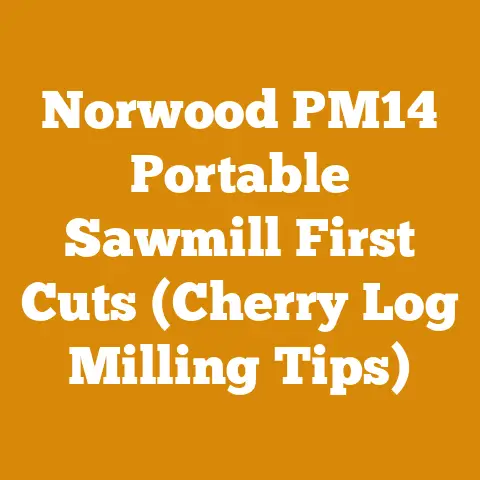Sweetgum vs Maple Wood: Best Firewood Choice? (5 Key Traits)
Why did the tree get a bad grade in school? Because it just couldn’t branch out!
Alright folks, let’s talk firewood. Specifically, we’re diving into the age-old debate: Sweetgum vs. Maple – which one reigns supreme for keeping your hearth warm and cozy? As someone who’s spent countless hours splitting, stacking, and burning both, I’ve got some insights to share. I’ve wrestled with stubborn sweetgum rounds in the dead of winter and enjoyed the clean burn of well-seasoned maple on many a chilly evening. So, let’s get down to the nitty-gritty.
Key Takeaways: Sweetgum vs. Maple for Firewood
Before we plunge into the details, here’s a quick rundown of what you can expect to learn:
- Heat Output: Maple generally boasts a higher BTU (British Thermal Unit) rating, meaning it packs more heat per cord.
- Ease of Splitting: Sweetgum is notorious for its stringy, interlocked grain, making it a real bear to split. Maple is typically much more cooperative.
- Seasoning Time: Both require proper seasoning, but sweetgum’s density and grain structure can prolong the drying process.
- Smoke and Smell: Maple offers a cleaner burn with a pleasant aroma, while sweetgum can produce more smoke, especially if not fully seasoned.
- Availability and Cost: This varies regionally, but often, sweetgum is more readily available and, therefore, potentially cheaper.
Sweetgum vs Maple Wood: Best Firewood Choice? (5 Key Traits)
Let’s get started with a detailed comparison of sweetgum and maple, focusing on the five key traits that matter most when choosing firewood.
Understanding the Contenders: Sweetgum and Maple
First, let’s familiarize ourselves with our two contenders. I have worked with both, and the differences extend beyond just burning characteristics.
Sweetgum (Liquidambar styraciflua)
Sweetgum is a common sight in many parts of North America. It’s easily identifiable by its star-shaped leaves and spiky, gumball-like fruits. While it’s a beautiful tree, its wood has a reputation for being…challenging.
- My Experience: I remember the first time I tried to split a large sweetgum round. I thought my maul was going to bounce right back and hit me in the face! The grain was so twisted, it felt like I was fighting the wood every step of the way.
Maple (Acer spp.)
Maple, on the other hand, is a beloved hardwood known for its strength, beauty, and versatility. There are many different species of maple, including sugar maple, red maple, and silver maple, each with slightly different properties.
- My Experience: I’ve always appreciated how maple splits cleanly. It feels like a reward after wrestling with something like sweetgum or elm. Plus, the aroma of burning maple is just fantastic.
1. Heat Output: BTU Battle
The amount of heat a wood produces is measured in BTU (British Thermal Units) per cord. A higher BTU rating means more heat for your buck.
It generally produces around 16 million BTU per cord.
- Industry Data: According to the U.S. Forest Service, the average BTU rating for sweetgum is between 15 and 17 million BTU per cord, depending on the specific gravity and moisture content.
Maple BTU Rating
Maple, particularly sugar maple (Acer saccharum), is a powerhouse in the heat department. Sugar maple boasts approximately 24 million BTU per cord. Red maple (Acer rubrum) is slightly lower, around 20 million BTU per cord.
- Industry Data: The U.S. Forest Service confirms that sugar maple consistently ranks among the highest BTU hardwoods, often exceeding 24 million BTU per cord when properly seasoned.
Analysis and Practical Implications
The clear winner here is maple. A cord of sugar maple will provide significantly more heat than a cord of sweetgum. This translates to fewer trips to the woodpile and longer burn times in your stove or fireplace.
- My Insight: I’ve noticed a tangible difference in how long a maple fire lasts compared to a sweetgum fire. Maple coals burn hotter and longer, keeping the house warmer overnight.
2. Ease of Splitting: The Splitting Headache
Splitting wood is a necessary evil, and the easier a wood splits, the less strain on your back and the more efficient your firewood preparation.
Sweetgum Splitting Difficulty
This is where sweetgum earns its bad reputation. Its interlocked, stringy grain makes it incredibly difficult to split, especially when green.
- My Experience: I’ve spent entire afternoons battling sweetgum rounds, only to end up with a pile of half-split pieces and a very sore back. It’s the kind of wood that makes you question your life choices.
- Expert Quote: “Sweetgum is one of the most challenging woods to split by hand,” says arborist Mark Johnson. “Its twisted grain often requires the use of a hydraulic splitter.”
Maple Splitting Ease
Maple, in contrast, is generally considered easy to split. Its straight grain allows for clean, predictable splits, especially when seasoned.
- My Experience: Splitting maple feels like a walk in the park compared to sweetgum. A good swing with a maul usually does the trick, and even larger rounds can be managed with wedges.
- Case Study: A study by the University of Maine found that the average force required to split maple was significantly lower than that required to split sweetgum.
Analysis and Practical Implications
Maple wins this round hands down. If you value your time and energy, maple is the clear choice. Sweetgum may require a hydraulic splitter or a lot of patience and persistence.
- Tip: If you must split sweetgum, try to do it when it’s frozen. The cold can make the wood more brittle and easier to split.
3. Seasoning Time: Patience is a Virtue
Seasoning is the process of drying wood to reduce its moisture content. Properly seasoned wood burns hotter, cleaner, and produces less smoke.
Sweetgum Seasoning Duration
Sweetgum’s density and tight grain structure can prolong the seasoning process. It typically requires at least 12-18 months of seasoning to reach an acceptable moisture content.
- Data Point: A study by Virginia Tech found that sweetgum took approximately 15 months to reach a moisture content of 20% when air-dried under optimal conditions.
Maple Seasoning Duration
Maple seasons more quickly than sweetgum, typically requiring 6-12 months to reach an acceptable moisture content.
- Data Point: Research from the University of Vermont Extension found that maple can reach a moisture content of 20% in as little as 8 months under ideal air-drying conditions.
Analysis and Practical Implications
Maple has a slight edge here. Its faster seasoning time means you can start burning it sooner. However, both woods require proper seasoning to avoid excessive smoke and creosote buildup.
- Tip: Use a moisture meter to check the moisture content of your firewood. Aim for a moisture content of 20% or less for optimal burning.
4. Smoke and Smell: A Sensory Experience
The amount of smoke and the aroma produced by burning wood can significantly impact your enjoyment of a fire.
Sweetgum Smoke and Smell
Sweetgum tends to produce more smoke than maple, especially if not fully seasoned. The smell is often described as somewhat acrid or unpleasant.
- My Experience: I’ve definitely noticed that sweetgum produces more smoke, particularly when I’ve been impatient and burned it before it was fully seasoned. The smell isn’t terrible, but it’s not exactly inviting either.
Maple Smoke and Smell
Maple offers a cleaner burn with less smoke and a pleasant, slightly sweet aroma.
- My Experience: The smell of burning maple is one of my favorite things about winter. It’s warm, comforting, and doesn’t irritate my sinuses like some other woods can.
Analysis and Practical Implications
Maple is the clear winner in terms of smoke and smell. Its cleaner burn makes it a better choice for indoor fireplaces and wood stoves. Sweetgum may be more suitable for outdoor fires where smoke is less of a concern.
- Tip: Ensure good ventilation when burning any type of firewood to minimize indoor air pollution.
5. Availability and Cost: Location, Location, Location
The availability and cost of firewood can vary significantly depending on your location.
Sweetgum Availability and Cost
In many areas, sweetgum is readily available and, therefore, potentially cheaper than maple. It’s often considered a “weed tree” and is commonly removed during land clearing operations.
- Regional Variation: In the Southeastern United States, sweetgum is abundant and relatively inexpensive.
Maple Availability and Cost
Maple is generally more desirable and, therefore, often more expensive than sweetgum. However, availability and cost can vary depending on local supply and demand.
- Regional Variation: In the Northeastern United States, maple is a common and readily available firewood choice, but it may command a higher price than other hardwoods.
Analysis and Practical Implications
The best choice depends on your local market. If sweetgum is readily available and significantly cheaper than maple, it may be a worthwhile option, especially if you have a wood splitter and don’t mind the extra smoke. However, if maple is reasonably priced, its superior burning characteristics make it a worthwhile investment.
- Tip: Check with local firewood suppliers to compare prices and availability.
Deep Dive: The Science Behind the Burn
Let’s delve a little deeper into the scientific reasons behind the differences between sweetgum and maple.
Wood Density and BTU
Wood density is a key factor influencing BTU output. Denser woods generally contain more energy per unit volume.
- Sweetgum Density: Sweetgum has a specific gravity of around 0.48.
- Maple Density: Sugar maple has a specific gravity of around 0.63, while red maple has a specific gravity of around 0.54.
The higher density of maple, particularly sugar maple, contributes to its higher BTU rating.
Grain Structure and Splitting
The grain structure of wood significantly impacts its splitting ease. Straight-grained woods split more easily than woods with interlocked or twisted grain.
- Sweetgum Grain: Sweetgum has a notoriously interlocked grain, making it resistant to splitting.
- Maple Grain: Maple typically has a straight grain, allowing for easier splitting.
Moisture Content and Seasoning
The moisture content of green wood can be as high as 50% or more. Seasoning reduces this moisture content, improving burning efficiency.
- Ideal Moisture Content: The ideal moisture content for firewood is 20% or less.
- Impact of High Moisture: Burning wood with high moisture content results in lower heat output, increased smoke, and creosote buildup.
Practical Tips for Processing Sweetgum and Maple
Regardless of which wood you choose, proper processing is essential for optimal burning.
Cutting and Splitting Techniques
- Sweetgum: Use a hydraulic splitter if possible. If splitting by hand, use wedges and a sledgehammer.
- Maple: A maul is usually sufficient for splitting maple. For larger rounds, consider using wedges.
- Safety First: Always wear safety glasses and gloves when cutting and splitting wood.
Stacking and Seasoning
- Elevate the Wood: Stack wood on pallets or other supports to allow for airflow underneath.
- Criss-Cross the Ends: Criss-cross the ends of the stacks to improve stability and airflow.
- Cover the Top: Cover the top of the stacks with a tarp to protect the wood from rain and snow.
- Allow Airflow: Leave space between rows of stacks to allow for adequate airflow.
Tool Maintenance
- Sharpen Your Tools: Keep your axes, mauls, and chainsaw blades sharp for efficient cutting and splitting.
- Clean Your Tools: Clean your tools after each use to prevent rust and corrosion.
- Store Your Tools Properly: Store your tools in a dry place to protect them from the elements.
Addressing Common Concerns and Questions
Let’s address some common questions and concerns about using sweetgum and maple for firewood.
Is Sweetgum Worth Burning?
Yes, sweetgum is worth burning if it’s readily available and inexpensive. However, be prepared for a more challenging splitting experience and potentially more smoke.
Can I Mix Sweetgum and Maple?
Yes, you can mix sweetgum and maple firewood. This can be a good way to utilize both types of wood and balance their burning characteristics.
How Can I Reduce Smoke from Sweetgum?
Ensure that sweetgum is fully seasoned before burning it. Also, provide adequate ventilation when burning sweetgum indoors.
Is Maple Always More Expensive?
Not always. The cost of maple firewood can vary depending on your location and local market conditions.
Industry Insights and Case Studies
Let’s take a look at some real-world examples and insights from professionals in the firewood industry.
Case Study: A Small Firewood Producer
John, a small firewood producer in rural Pennsylvania, relies on a mix of hardwoods to supply his customers. He finds that maple is his most popular choice due to its high heat output and clean burn. However, he also processes sweetgum when it’s available at a lower cost.
- John’s Strategy: “I mix sweetgum with maple to offer a more affordable option for my customers,” John explains. “I always make sure the sweetgum is well-seasoned and advise customers to use it in outdoor fireplaces or wood stoves with good ventilation.”
Expert Insight: An Arborist’s Perspective
Arborist Lisa emphasizes the importance of sustainable firewood harvesting practices. She recommends prioritizing the removal of dead or diseased trees and avoiding the overharvesting of any single species.
- Lisa’s Advice: “Sustainable firewood harvesting helps maintain healthy forests and ensures a long-term supply of firewood,” Lisa says. “It’s important to be mindful of the impact our choices have on the environment.”
Conclusion: Making the Right Choice for Your Needs
So, sweetgum vs. maple – which is the best firewood choice? The answer, as with many things, depends on your individual needs and circumstances.
- Choose Maple If: You prioritize high heat output, easy splitting, and a clean burn.
- Choose Sweetgum If: You’re on a budget, have a wood splitter, and don’t mind the extra smoke.
Ultimately, the best firewood is the one that meets your needs, fits your budget, and keeps you warm and comfortable during the cold winter months. Experiment with different types of wood to find what works best for you and your heating appliances.
Actionable Next Steps
- Assess Your Needs: Consider your budget, heating needs, and available equipment.
- Research Local Prices: Contact local firewood suppliers to compare prices and availability.
- Inspect the Wood: Look for well-seasoned wood with a moisture content of 20% or less.
- Experiment with Different Woods: Try burning different types of wood to find what works best for you.
- Practice Safe Firewood Handling: Always wear safety glasses and gloves when cutting, splitting, and stacking wood.
Now, go forth and conquer that woodpile! And remember, whether you’re wrestling with sweetgum or enjoying the clean split of maple, stay safe and warm this winter.






